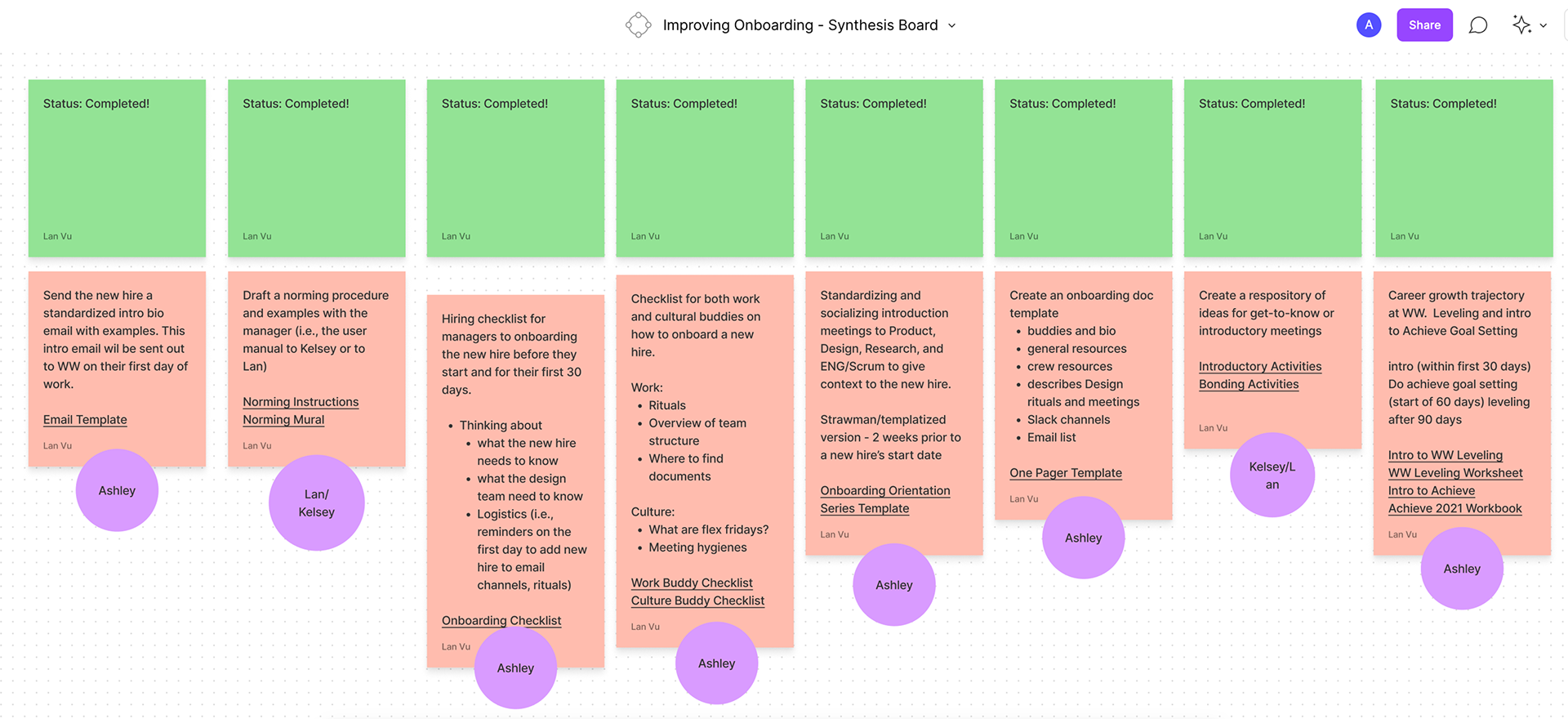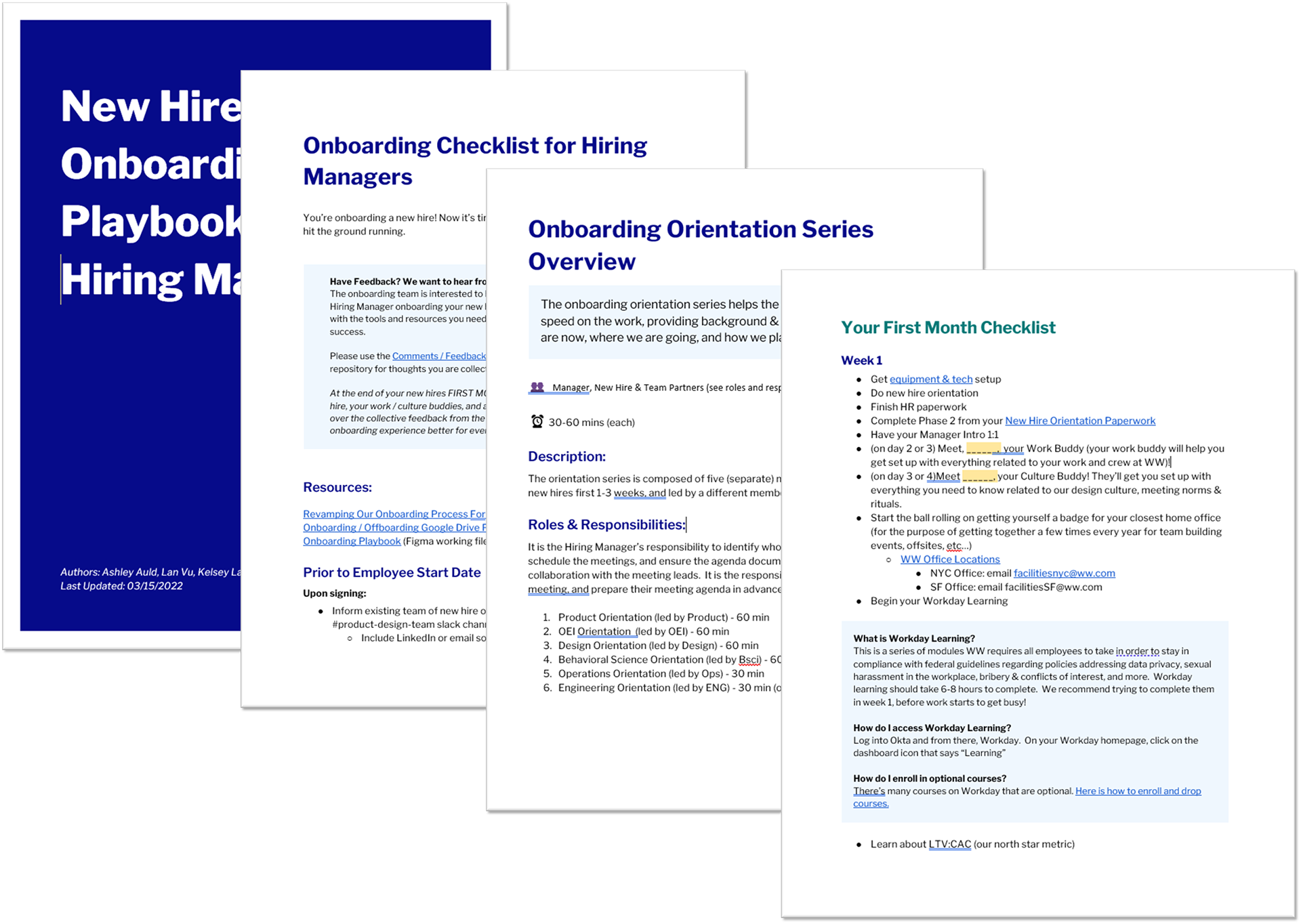My Role as a Design Leader & Manager
In addition to my responsibilities of leading product design initiatives within my team, I am also a people manager, mentor, hiring manager and a member of the design leadership team.
As a people manager, I pay special attention to the needs of my direct reports by holding weekly 1:1's, having quarterly career conversations, work with them on their individual development plans (IDPs), conduct bi-annual 360 peer reviews, guide design critiques, hold personal & group norming sessions, and give constant feedback loops around areas of growth and praise for jobs well done.
As a member of the design leadership team, I contribute to improving product design team processes & practices, design operations, creating safe spaces, and setting remote-first cultural norms. The following case study outlines the work I did in this space for my team at WW.
The Problem
Without getting into specifics, there were some problems with how the product org and the business were operating at WW, which trickled down to the Product Design team in unhelpful ways. Team members were experiencing burnout, frustration, and while people enjoyed having the flexibility and convenience of working remote, they felt like the culture was lacking.
"What does our design culture look like in a work from wherever world?"
We had a vulnerable conversation during our monthly design team all hands. Afterwards, the design leadership team made it a priority to take aggressive action towards addressing this sentiment, starting with understanding the problem in more detail.
Gathering Facts
Each manager began to hold monthly retros with their teams to prompt honest conversations about what was not working well, understand the areas they wanted to change, and empathize with their pain points. This was my teams retro board. We worked on it over the course of a couple of weeks.
"HMW create a better design culture in a work from wherever world?"
The Retros Provided 5 Key Insights
LACK OF PROCESS & ACCOUNTABILITY - Lack of alignment on problem definition, efficient processes, and product strategy was resulting in feelings of burnout and unsafe environments, especially in meetings with executive leadership.
LACK OF OPPORTUNITY TO MAKE AN IMPACT - We felt like a feature factory, and design was tired of being treated like a service provider and always being told what to do.
ZOOM / MEETING FATIGUE - Too many back-to-back meetings (without agendas or goals) caused inadequate time for deep work, harming work/life balance.
ORGANIZATIONAL SILOS - We were organized in many disparate cross-functional crews, with no holistic view of the connected experience. It became increasingly apparent during my tenure that working this way was hurting our ability to deliver a good product experience.
LOSS OF CULTURAL IDENTITY - With the abrupt shift to full-time remote, being in “survival mode” became the norm. We were losing sight of our design culture and ability to connect as humans. This was exacerbated by the Zoom fatigue.
Solving the Problem(s)
I was deeply involved with implementing solutions for the last three problems around Zoom fatigue, organizational silos, and loss of cultural identity. The first two problems were more systemic and needed to be addressed in parts. The process piece would be addressed by an amazing cross functional team of PM's, Product Designers & Researchers. I contributed to that work by giving feedback at various stages, but a different design leader was leading it.
______________________________
Fighting the "Zoombie" Apocalypse
Ideation Workshop
As part of our retro board, I led brainstorms with my team to generate ideas for how we might alleviate the problem of Zoom / meeting fatigue:
HMW make meetings a more effective, efficient use of everyone's time?
HMW make more room in our day to day for deep work?
HMW set realistic expectations for the time it takes to accomplish our work?
Special credit to Nobl for this brilliant decision tree / inspiration
Solution 1. Create / Enforce Meeting Hygiene & Guidelines
Working with my Sr. Designer, we created a series of guidelines for enforcement across our org. All meetings were required to have agendas in advance, embedded meeting notes (esp. for recurring meetings), and guidelines for when something should be a meeting vs. a slack communication. We socialized this across our org, and I empowered the design team to hold meeting owners accountable by declining any meetings that did not follow the guidelines.
Solution 2. Standardize Calendars
I did a team audit of current calendars, to understand what types of meetings they currently had, frequency, and volume, as well as preferences for standardization.
From that, I created a sample standardized calendar to present to the team, get feedback, then socialized cross functionally to get buy in. Everyone suffered from Zoom fatigue, so there was eagerness to try anything that might help.
Solution 3. Kanban & Alignment Ceremonies
To combat burnout, ensure alignment on problems to solve, and get better visibility on progress being made, I worked with my product peers to install weekly product & design alignment ceremonies. We established a design team Kanban board, which gave the team more visibility of the product backlog, allowed them to discuss the problem statements to ensure clarity, assign ownership, and size problems to set expectations and timelines.
______________________________
Breaking the Silo's
Defining the Problem
The design team had operated within a cross-functional crew-based structure for years, often organized by tab or app feature. For small teams this is fine, but as the org grew, this organizational model did not scale well and invited many problems:
Silo'd ways of working - There was a lot of overlap with different crews solving the same problem, and not knowing what other teams were working on.
Lack of connected ownership - no one was empowered to consider the "big picture".
A poor product experience - The app was overwhelming and confusing to navigate due to many silo'd decisions made over the course of years.
Workshopping & Ideation
I worked very closely with another Product Design Manager to pressure test different models and frameworks, and run through scenarios. When we landed on one we agreed on and felt good about, we socialized with leaders to get feedback and buy in, then with IC's to clarify questions or concerns.
After multiple iterations, we successfully reorganized from ~14 silo'd crews to 4 "pods" that covered the end-to-end customer experience, organized by thematic customer problems.
______________________________
Team Culture in a Remote World
Ideation Workshop
In the same retro board, we also brainstormed ways we could address the remote-first cultural challenges and need for human connection:
HMW onboard remote new hires so that they feel supported, guided, and are able to get to know their teammates as people?
HMW make work feel productive, fun, energizing, connected?
HMW set remote-based communication norms & expectations?


Solution 1: Revamp our Onboarding Process to be Remote-friendly
I worked closely with two other product designers from the team to completely reinvent our Product Design onboarding process to be remote friendly.
We interviewed recent new hires, identified pain points, extracted insights, and ideated on solutions as a team.
We created an onboarding "playbook" that would serve as the guide for hiring managers who were bringing on new employees.
We installed retros with new hires going through the revamped process to gather feedback and suggestions for further improvement.
The Onboarding Playbook was wildly successful, it was shared to the highest levels of our organization, and adapted for Product Management, Experience Research, and Service Design onboarding soon after it was released.
Solution 2: Fostering remote-friendly human connections
I took a backseat and really let the team lead this one, as it was something they were passionate about. They set up monthly meetings, calling themselves "The Connect Club" where they brainstormed ideas on ways to create meaningful human connections across our team. I served as their "executive sponsor," bridging the gap with leadership to secure budgeting for fun events and ensure they felt empowered to enact changes.
We started special interest "for fun" Slack channels, set up monthly team building events over Zoom, held asynchronous fun art activities, and created new norms like remote-friendly birthday and work anniversary celebrations.
Solution 3: Standardize Digital Hygiene Best Practices
The entire leadership team participated and contributed to this one, particularly our Design Program Manager.
We installed new Slack norms, such as displaying pronouns beside names, connecting Slack with google calendar, setting OOO status messages, and using slack reminders to set recurring meeting agendas (like design crit) in advance.
We also created Zoom etiquette guidelines, such as using the "hand raise" feature when someone wanted to speak, encouraging chat-based participation in large meetings, assigning meeting facilitators and rotating note-takers, recording meetings, and camera off when passively observing / not presenting,
______________________________
Team Results
After we began to implement these changes, the sentiment in subsequent retro's became more and more positive!
Complaints about Zoom fatigue lessened significantly (to the point where teams were happy to meet on zoom for more social / fun events)
One of our newer hires told me she felt like she was finally getting to know everyone on the team. And another new hire told me her onboarding experience has been "the best she'd ever had at a company."
The reorg is still being ironed out, but definitely shows promising signs. Teams are no longer solving problems inside "their tab" but exploring solutions across the member journey.
There was still a ways to go, but it's great to see that the team recognized and appreciated these changes.
October Retro board, for the first time, MORE green than red!